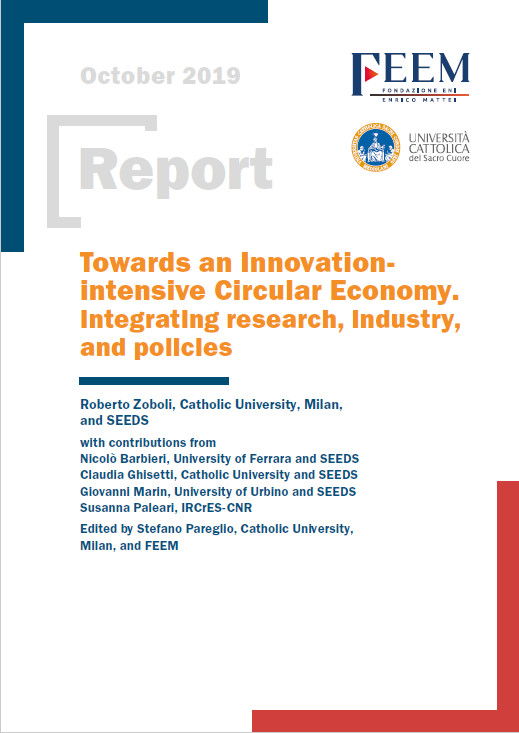Towards an Innovation-intensive Circular Economy. Integrating Research, Industry and Policies

31.10.2019
The report ‘Towards an Innovation-intensive Circular Economy. Integrating research, industry, and policies’ is a result of the cooperation between FEEM and Università Cattolica. The report proposes an original perspective to the circular economy as a paradigm of change that involves the whole production system. While material circularity is increasing under the pressure of decades of waste/recycling policies in Europe and Italy, a ‘new’ circular economy more intensive of technological and social innovation is establishing itself beyond the waste/recycling system, and it involves the material and organisational efficiency of enterprises and the whole production/consumption systems.
The report starts from a stocktaking of definitions, public policies, quantifications, innovations, and institutional initiatives on the circular economy in Europe and in Italy.
Two ‘integrative approaches’ are then proposed for achieving a better interaction between research, industry, and policies. The first approach exploits the concepts of ‘System of innovation’ (national, regional, sectoral) to redefine the process towards a circular economy. In such a ‘System of innovation’, enterprises are at the core, and the sub-systems of policies, finance, research/university, and civil society can contribute, through network interactions, to the change of the industrial and consumption paradigms towards resource efficiency and circularity. By means of this approach, it is easier to understand the importance of internal factors (for example industrial capabilities and strategies) as well external factors (for example European research programmes and finance) in creating opportunities or barriers to the circular economy. The second ‘integrative’ approach mirrors the intrinsically systemic features of the circular economy by suggesting to put it in connection to other major transitions of this phase, in particular decarbonisation and the bioeconomy, through a NEXUS-type approach. The interactions between circular economy, decarbonisation, and the bioeconomy are several but not necessarily they are synergic in that potential conflicts may arise. Synergies and conflicts, for example through an intensive use of biomass for energy, are not fully recognised by policies, which are still designed and implemented with a sector-minded approach. This can impair the performance of enterprises in pursuing a profitable circularity strategy.
The report also addresses some open issues in the ‘economics of the circular economy’, like the low prices of primary commodities that do not create incentives to circularity innovations, thus assigning a major burden to policy instruments (for example fiscal instruments), and the changing attitude of the financial sector, which is moving towards the adoption of circularity criteria in the allocation for financial resources.
